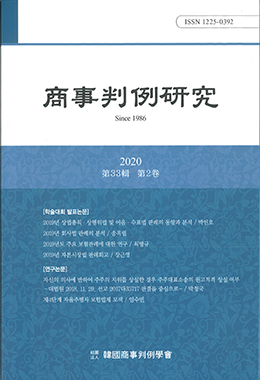이 논문에서는 주주간 계약에서 동반매도청구권의 기능과 의미 및 행사 조건에 대한 해석론을 처음으로 다루고 있는 대법원 2021. 1. 14. 선고 2018다223054 판결과 관련하여 사실관계와 당사자들의 주장, 하급심을 포함한 각 심급 판시사항의 주요 쟁점을 동반매도청구권에 초점을 맞추어 살펴본다. 대상 사건의 주요 쟁점은 항소심과 상고심을 거치면서 보다 구체화 되었거나, 각 심급 별로 의견이 달라졌기 때문에 각 심급의 판단을 모두 살펴보는 데에 논의의 효용이 있다. 그 후 동반매도청구권의 조건 및 조건의 성취와 관련한 쟁점들을 해석론의 관점에서 보다 심층적으로 검토하고, 나아가 소수주주의 권리 보호 방안에 대해 논의한다.
동반매도청구권은 법령에 그 근거가 없고 완전히 사적인 합의인 주주간 계약에서 발생하는 권리이기 때문에, 판결에서 그 권리의 유효성을 인정하는 것은 향후의 조항의 활용 가능성을 높이고 관련된 실무의 방향성을 제시하며, 관련 법리를 보다 구체화하는 토대가 된다는 점에서 큰 의미를 갖는다. 대상 판결을 통해 동반매도청구권의 구체적인 기능과 의미, 행사 시 협조 의무의 범위에 대한 해석론에 있어 구체적인 방향이 제시되었다는 점에서 대상 판결이 시사하는 바가 크다. 비록 대법원에서 동반매도청구권의 행사 조건이 무엇인지에 대해서는 기준을 명시하지 않았다고 볼 여지가 있으나, 이 부분은 결국 주주간 계약에서 계약 조건을 보다 명확히 정하도록 사적 영역에 남겨둘 수밖에 없다. 다만, 실무에서 계약 조건을 정할 때에 동반매도청구권 조항을 통해 추구하고자 했던 목적 - 소수주주의 투자금 회수 방안 확보 - 을 보다 실질적으로 달성할 수 있는지에 대해서는 보다 적극적인 논의가 필요하다. 대상 사건과 같이 대주주가 매각절차 초기에서부터 협조를 거부하여 매각절차가 진행되지 않는 경우, 소수주주는 본인이 보유하고 있는 지분에 대한 경제적 이익을 전혀 얻을 수 없기 때문이다. 향후 동반매도청구권을 행사할 때에 어떠한 방식으로 매각절차의 진행을 촉구할지, 매도가액과 대상자를 좁은 범위로나마 특정하여 조건 성취의 기대권을 확보할 수 있을지, 매각절차의 각 단계에서 당사자들의 권리와 의무 및 그 불이행의 효과는 무엇인지를 단계별로 구체적으로 규정할 수 있도록 향후 실무를 정립해 갈 필요가 있다.
This study examines the major issues of each instance judgment including the fact relevance, claims by the persons directly involved, and lower instance in relation to Decision2018Da223054 decided by the Supreme Court on January 14th, 2021, which is the first case covering the functions and meaning of the drag-along right and the conditions where the drag-along right shall be exercised in shareholders’ agreements with a focus on the drag-along right. Since the court’s judgment on the major issues was further concretized or the opposite conclusion was reached as going through the trials at the Appeal Court and Supreme Court, respectively, there is a significance of discussion in identifying all the judgments by each instance. Then, conditions for the drag-along right and issues with regard to achieving the conditions are reviewed from the perspective of interpretation more thoroughly, and a discussion on how to protect minor shareholders’ rights is conducted.
The drag-along right is the one generated in the shareholders’ agreement, which is a completely private settlement, so the court’s approving validity of the right is significant in that it sets the stage for the future utilization of its clauses, suggests the direction for practical affairs, and gives shape to relevant legal principles. This judgment suggests a great deal in that the functions and meaning of this right were identified and a specific direction on the scope of cooperative obligation at the exercise of this right was reached. Although it can be seen that the Supreme Court did not explicitly present the criteria for the exercise of the drag-along right, this part will eventually have to be left to individuals to make the contract terms and conditions clearer in shareholders’ agreements. However, more active discussions will be needed on whether minority shareholders can substantially achieve the purpose - securing the return on investment - that they have pursued through the clauses of drag-along right. This is because if major shareholders refuse to cooperate from the beginning of the sale and the sale procedure is not advanced, as in the case of the subject matter, minority shareholders will not be able to gain any economic benefit from their shares. Details on how to urge the sale procedure, whether the selling price and subject can be specified within at least a narrow range and the expectant right of fulfillment of condition can be secured, and the effects of rights and obligation of the persons directly involved and their failure in duty at each stage of exercising the drag-along right in the future should be practically established further.




